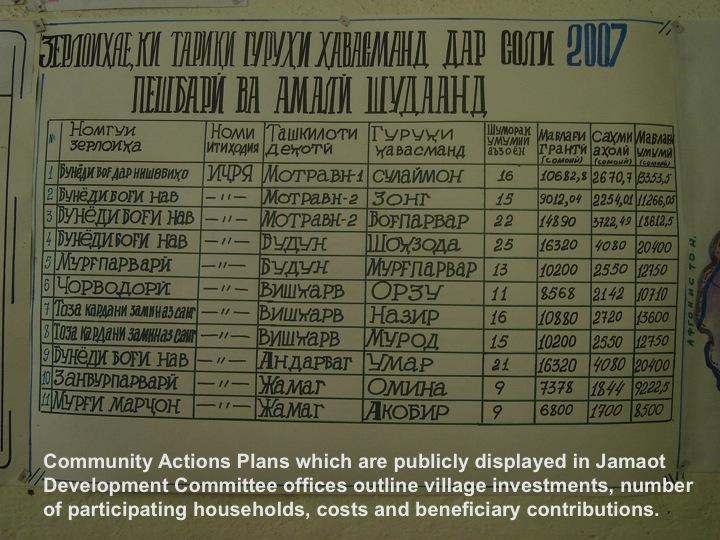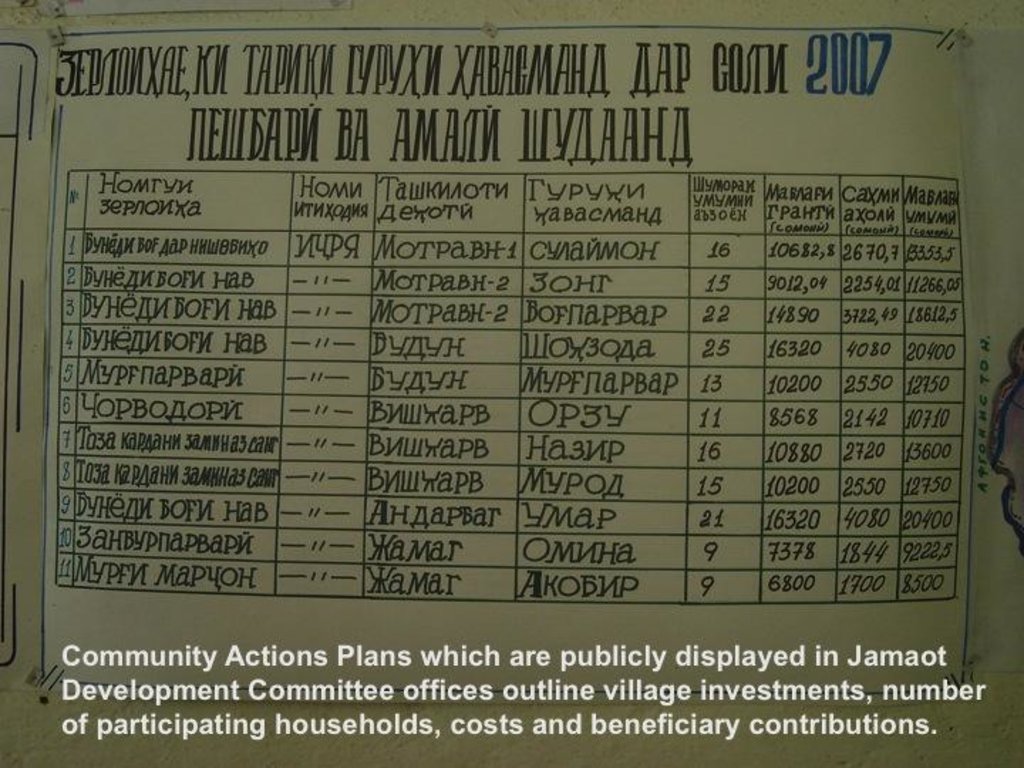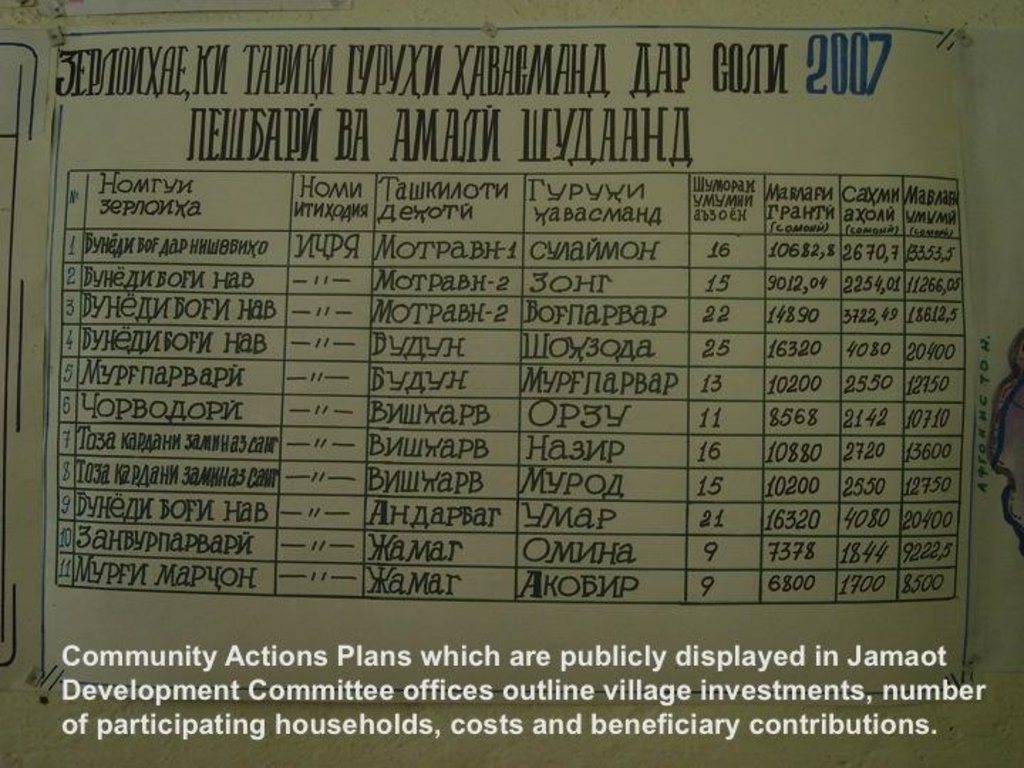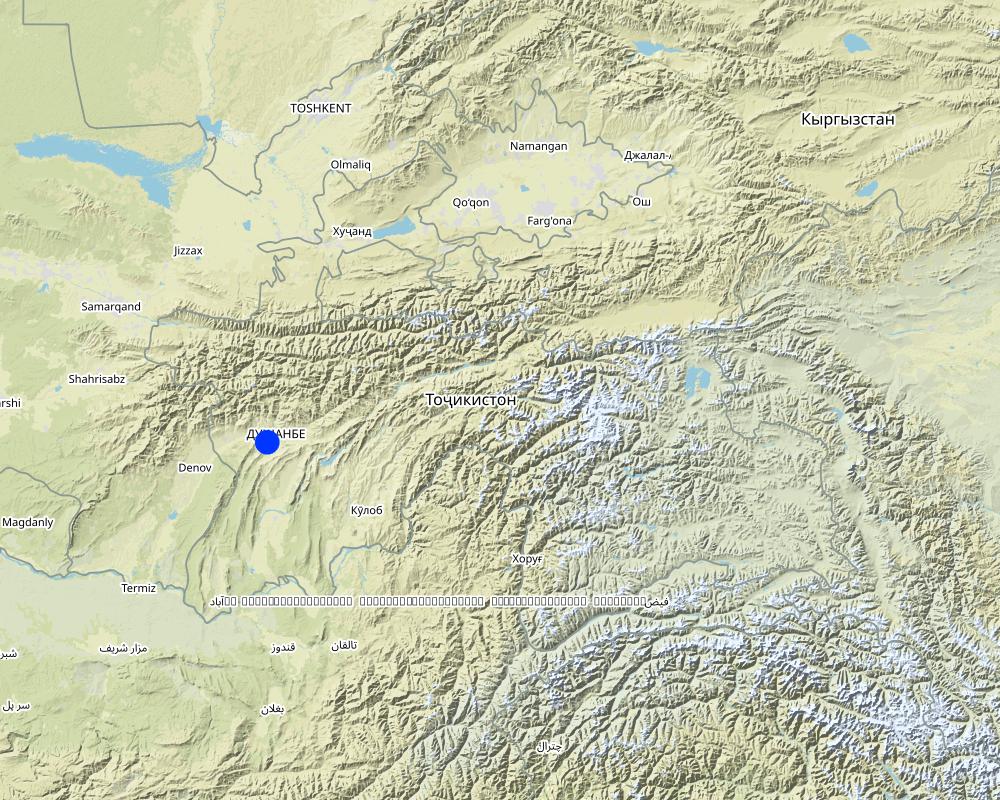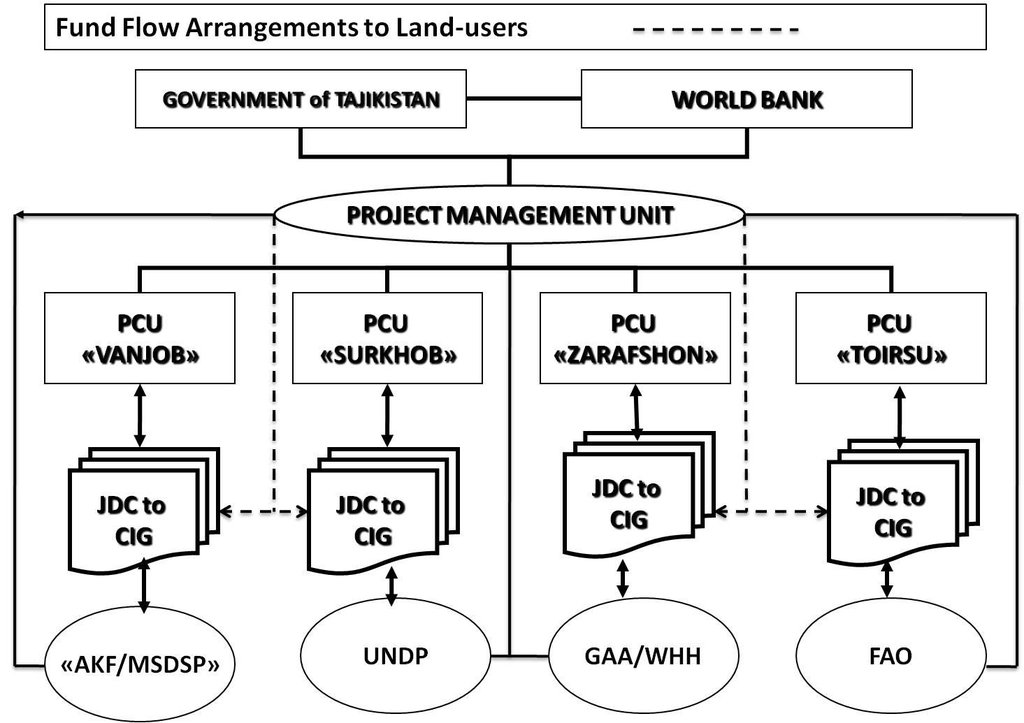SLM small grant allocation mechanisms [塔吉克斯坦]
- 创建:
- 更新:
- 编制者: Nandita Jain
- 编辑者: –
- 审查者: David Streiff, Alexandra Gavilano, Joana Eichenberger
approaches_2453 - 塔吉克斯坦
查看章节
全部展开 全部收起1. 一般信息
1.2 参与方法评估和文件编制的资源人员和机构的联系方式
SLM专业人员:
Mott Jessica
World Bank
有助于对方法进行记录/评估的项目名称(如相关)
Pilot Program for Climate Resilience, Tajikistan (WB / PPCR)有助于对方法进行记录/评估的机构名称(如相关)
World Bank (World Bank) - 美国1.3 关于使用通过WOCAT记录的数据的条件
编制者和关键资源人员接受有关使用通过WOCAT记录数据的条件。:
是
2. SLM方法的描述
2.1 该方法的简要说明
Mechanisms to facilitate participatory decision-making about grant allocation among land users and improve transparency and accountability in flow of funds to beneficiaries in small-grant programmes for SLM.
2.2 该方法的详细说明
该方法的详细说明:
Aims / objectives: As part of the Community Agriculture & Watershed Management Project (CAWMP), this approach helped beneficiaries and project partners allocate grants and manage the flow of funding while promoting fairness, transparency, and ownership. It facilitated appropriate SLM choices across the highly variable agricultural, climatic and geographic conditions. Almost 4000 rural investments including SLM technologies were implemented, resulting in over 96,000ha under improved land management practices and benefits for more than 43,000 households in Tajikistan’s uplands.
Methods: This approach set a fixed budget per village, limited the grant value received per household as well as the total size of any one grant, required minimum levels of beneficiary contributions, and provided grant money to beneficiaries, enabling them to purchase the inputs.
Stages of implementation: Fixed village budget: In their Community Action Plans (CAP) villages assigned priorities to grants within a set budget amount for the entire village. Project guidelines specified a formula for this budget based on amounts per investment type per household excluding beneficiary contributions ($30/household for farm productivity, $74/household for land management, and $30/household for rural infrastructure). The number of households in a village multiplied by these per-household-amounts determined the overall size of the grant funding for that village. Grant allocation limits. The villages were informed of their overall budget as well as the household limits for each category. They chose investments for groups of households (Common Interest Groups, CIGs) and allocated grant funds to subprojects accordingly. The household limits ensured that collectively at least 50% of the families would benefit directly. In practice, about 75%, of a total of about 57000 households in the project sites participated in the farm productivity and land resource management investments, and 60% in rural infrastructure investments. Grant size. Except in a few cases requiring special approval, the Project-financed grants for each subproject were lower than US$5,000, which reduced risks of the funds being used for purposes for unrelated to the Project. Beneficiary Contribution. Beneficiaries were required to contribute a minimum of 25% of the grant amount in labor, materials or cash which increased their stake in the investment, thereby strengthening ownership and sustainability. At least 5% of the grant amount for rural infrastructure had to be contributed in cash at the start in order to demonstrate financial sustainability.
Role of stakeholders: Fund flow. Once a grant proposal was approved, the PMU transferred the grant amount to the local savings bank according to the schedule specified in the agreement between Jamoat Development Committee (JDC) and CIGs. The JDC accountant transferred the funds fromthe bank to the CIGs. The CIGs then had the responsibility for purchasing inputs, which created an incentive for selecting cost-effective inputs.
2.3 该方法的照片
2.5 采用该方法的国家/地区/地点
国家:
塔吉克斯坦
区域/州/省:
Sughd, Region of Republican Subordination, Khatlon, GBAO
有关地点的进一步说明:
Jirgital, Tajikibad, Vanj, Aini, Matcha, Penjikent, Danghara
注释:
The Community Agriculture and Watershed Management Project was implemented in four project sites/watersheds - Surkhob, Toirsu, Vanjob and Zarafshan - which included 7 districts/raions and 39 sub-districts/jamoats. The total catchment area was 35,000km2. Total arable, farm and pasture land was approximately 319,500ha.
Map
×2.6 该方法的开始和终止日期
注明开始年份:
2005
终止年份(若不再采用该方法):
2012
2.7 方法的类型
- 基于项目/方案
2.8 该方法的主要目的/目标
The Approach focused mainly on other activities than SLM (small grant programmes, participatory decision-making, village-level, fixed budgets, fund flow arrangements, farmer groups)
Practical and feasible mechanisms for beneficiaries and project partners for: a) grant allocation and fund flow that promote fairness, transparency, and beneficiary ownership in the context of Tajikistan; and b) facilitate appropriate SLM choices across the highly variable agro-climatic and other geographic conditions of the country.
The SLM Approach addressed the following problems: Prior to CAWMP, no practical incentives in donor-funded grant programmes for beneficiaries to consider how to optimise returns according to local conditions. Limited choice of technologies, elite capture of resources, requests for large grants and absence of beneficiary contributions led to inappropriate investments for local agro-climatic conditions, and poor returns and investments not maintained in subsequent years.
2.9 推动或妨碍实施本办法所适用的技术的条件
社会/文化/宗教规范和价值观
- 阻碍
Grant allocations vulnerable to elite capture and/or political influence. Time taken to address such pressures.
Treatment through the SLM Approach: Participatory planning and full disclosure at the start of planning to villagers of available funding and its calculation at village and household levels.
财务资源和服务的可用性/可得性
- 阻碍
Beneficiary dependence on donors/implementing agencies since resources given were “in-kind” and not cash.
Treatment through the SLM Approach: Adopted “good practice” from other countries with arrangements for direct cash transfers to beneficiaries organised as groups of farmers who then had responsibility for managing financial resources and procurement for chosen investments.
机构设置
- 阻碍
Lack of active participation by beneficiaries in decision-making over grant amounts and choice of investments.
Treatment through the SLM Approach: Innovative rules about grant allocations enabling villagers to consider various options of grant amounts and types of investments in a participatory manner, taking into account their local conditions.
了解SLM,获得技术支持
- 阻碍
Participatory planning processes lacked consideration of multiple factors, e.g., grant amount, choice of technologies, local context, beneficiary contribution, selection of beneficiaries.
Treatment through the SLM Approach: Inclusion of participatory rural appraisal, formulae and rules governing grant allocations in CAP preparation. First 3 proposals for each investment category in project sites reviewed to assess understanding of guidelines. Random review thereafter.
3. 相关利益相关者的参与和角色
3.1 该方法涉及的利益相关者及其职责
- 当地土地使用者/当地社区
CIGs (Groups of households)
Local cultural and social conditions determined the extent to which women took part in the grant allocation decision-making, and as members of CIGs managing small grant funds. In some more remote communities, it was not generally acceptable for women to be active participants. In other areas, women only CIGs were formed.
Marginal groups within a generally poor upland rural population participated in grant allocation decisions and as CIG members in managing small grant funds. In some villages, vulnerable and poor households were targeted as priority recipients of grants through the allocation mechanism.
Participated grant allocation decision making and fund management
- NGO
JDCs – locally registered NGOs
JDCs managed fund transfers to CIGs based based on formal agreements
- 国家政府(规划者、决策者)
Project Management Unit
如果涉及多个利益相关者,请注明领导机构:
Project Management Unit and CIGs
3.2 当地土地使用者/当地社区参与该方法的不同阶段
| 当地土地使用者/当地社区的参与 | 指定参与人员并描述活动 | |
|---|---|---|
| 启动/动机 | 无 | |
| 计划 | 被动 | Potential beneficiaries consulted for social assessment conducted during project design which then influenced project approaches. |
| 实施 | 互动 | Villagers made grant allocation decisions. CIGs managed grant funds and bought inputs. |
| 监测/评估 | 互动 | JDCs release grant funds according to benchmarks in formal agreements with CIGs. |
| Research | 无 |
3.3 流程图(如可用)
具体说明:
CAWMP - Implementation Arrangements and Fund Flow Arrangements to Land-Users
作者:
Project Management Unit (Dushanbe, Tajikistan)
3.4 有关SLM技术选择的决策
具体说明谁有权决定选择要实施的技术:
- 主要是土地使用者,由SLM专家提供支持
解释:
Villagers made decisions on grant amounts, types of investments and beneficiaries. SLM specialists from project partners such as FOS and PCUs assisted in choice of SLM technologies to be used for investments.
Decisions on the method of implementing the SLM Technology were made by mainly by land users supported by SLM specialists. See 2.1.5.1. above - How were decisions on the choice of SLM technologies made. Villagers made decisions on grant amounts, types of investments and beneficiaries. SLM specialists from project partners such as FOS and PCUs assisted in choice of methods for SLM technologies to be used for investments.
4. 技术支持、能力建设和知识管理
4.1 能力建设/培训
是否为土地使用者/其他利益相关者提供培训?:
是
明确受训人员:
- 土地使用者
- 现场工作人员/顾问
- JDCs
培训形式:
- 公开会议
涵盖的主题:
Grant allocation mechanisms. Fund flow arrangements and management.
4.2 咨询服务
土地使用者有权使用咨询服务吗?:
否
4.3 机构强化(组织发展)
是否通过这种方法建立或加强了机构?:
- 是,适度
具体说明机构的强化或建立程度:
- 本地
提供进一步细节:
JDCs received financial support for certain staff, some equipment for their offices, and training (see also TAJ047 for more information on JDC roles in the project). Note-cannot select more than one type of support in the pull-down menu
4.4 监测和评估
监测和评估是该方法的一部分吗?:
是
注释:
no. of land users involved aspects were regular monitored by project staff through measurements; indicators: Grant allocation – number of beneficiaries
Grant allocation aspects were regular monitored by project staff through observations; indicators: Grant allocation - Estimated costs of rural investments
Fund flow aspects were regular monitored by project staff through measurements; indicators: Fund flow - Timeliness of transfers from PMU to JDCs to CIGs,
There were few changes in the Approach as a result of monitoring and evaluation: Delays in initial fund flow to CIGs due to a lack of details in financial management arrangements. Elaboration of manuals and training addressed this problem.
There were no changes in the Technology as a result of monitoring and evaluation: Not directly relevant
5. 融资和外部物质支持
5.2 为土地使用者提供财政/物质支援
土地使用者是否获得实施该技术的财政/物质支持?:
否
5.4 信用
是否根据SLM活动的方法给予信用值?:
否
6. 影响分析和结论性陈述
6.1 方法的影响
该方法是否帮助土地使用者实施和维护SLM技术?:
- 否
- 是,很少
- 是,中等
- 是,支持力度很大
The grant allocation mechanism fostered multi-factor decision-making, including consideration of local environmental conditions, by villagers. Fund flow arrangements enabled JDCs to manage about $7.4 million in small grants to about 4000 CIGs for rural production investments.
该方法是否有助于社会和经济弱势群体?:
- 否
- 是,很少
- 是,中等
- 是,支持力度很大
The project population is considered generally poor or very poor. Within this population, particularly vulnerable groups participated in rural production investments.
Did other land users / projects adopt the Approach?
- 否
- 是,很少
- 是,中等
- 是,支持力度很大
: Portions of the approach and associated guidelines have been adopted in other donor-funded projects.
Did the Approach lead to improved livelihoods / human well-being?
- 否
- 是,很少
- 是,中等
- 是,支持力度很大
Mechanisms contributed to increased livelihood assets for more than 43,000 households through the implementation of about 4000 small grants.
Did the Approach help to alleviate poverty?
- 否
- 是,很少
- 是,中等
- 是,支持力度很大
Target population generally considered poor or very poor. Assessment of impacts on poverty are included in the project evaluation being conducted in 2011.
6.2 土地使用者实施SLM的主要动机
- 增加生产
- well-being and livelihoods improvement
6.3 方法活动的可持续性
土地使用者能否维持通过该方法实施的措施(无外部支持的情况下)?:
- 是
若是,请说明如何维持:
Grant allocation mechanism was understood and could be used for other sources of financing for groups of households at the village level. Fund flow mechanisms will require a sub-district presence to support transfers to village-based groups.:
6.4 该方法的长处/优点
| 土地使用者眼中的长处/优势/机会 |
|---|
| To be added based on project evaluation in 2011 |
| 编制者或其他关键资源人员认为的长处/优势/机会 |
|---|
| Grant allocation mechanism easily understood and perceived to be fair and transparent. (How to sustain/ enhance this strength: Document application and disseminate widely.) |
| Multiple factors considered in decision-making including grant amount, choice of investment and number of beneficiaries, local conditions. (How to sustain/ enhance this strength: Improved environmental analyses in participatory planning would lead to more suitable choice of investments.) |
| CIG management of funds contributed to improved accountability and incentives to sustain investments. (How to sustain/ enhance this strength: Document and disseminate methods and results.) |
7. 参考和链接
7.2 参考可用出版物
标题、作者、年份、ISBN:
perational Manual for Community Mobilization, Rural Production Investments and Research and Demonstration Grants (2008)
可以从哪里获得?成本如何?
Project Management Unit
标题、作者、年份、ISBN:
Operational Manuals for JDCs and CIGs in Financial Management and Procurement (2007)
可以从哪里获得?成本如何?
Project Management Unit
标题、作者、年份、ISBN:
CAWMP: Project Appraisal Document (2005)
可以从哪里获得?成本如何?
World Bank website
链接和模块
全部展开 全部收起链接
无链接
模块
无模块


